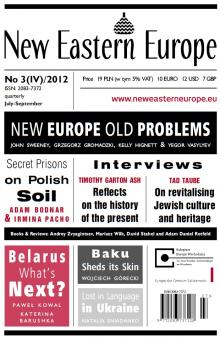
Building a Jewish Future
A conversation with Tad Taube, Chairman of the San Francisco-based Taube Philanthropies, and Honorary Consul for the Republic of Poland in the San Francisco Peninsula Region.
More...We kindly inform you that, as long as the subject affiliation of our 300.000+ articles is in progress, you might get unsufficient or no results on your third level or second level search. In this case, please broaden your search criteria.

A conversation with Tad Taube, Chairman of the San Francisco-based Taube Philanthropies, and Honorary Consul for the Republic of Poland in the San Francisco Peninsula Region.
More...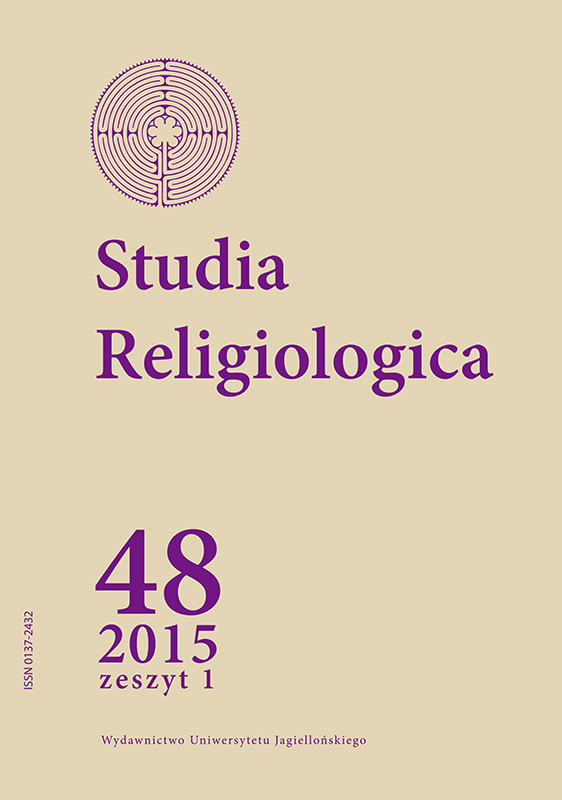
Oskar Goldberg’s hermeneutical approach eliminates from the text of the Pentateuch concepts crucial for its traditional – “rabbinic” – understanding. Based on deep etymological analysis, apathetical theory of language leads the German scholar to the conclusion that the idea of “sin” – among many others – was alien to the ancient Hebrews, who knew only the concept of “objective mistake”. Taking a diametrically different approach to the language of the Five Books of Moses, Aramaic translators develop the idea of “sin” as transgression and personal responsibility. This disagreement stems not only from two different visions of language of the Scripture, but is also determined by contrasting visions of god, man and their mutual relations.
More...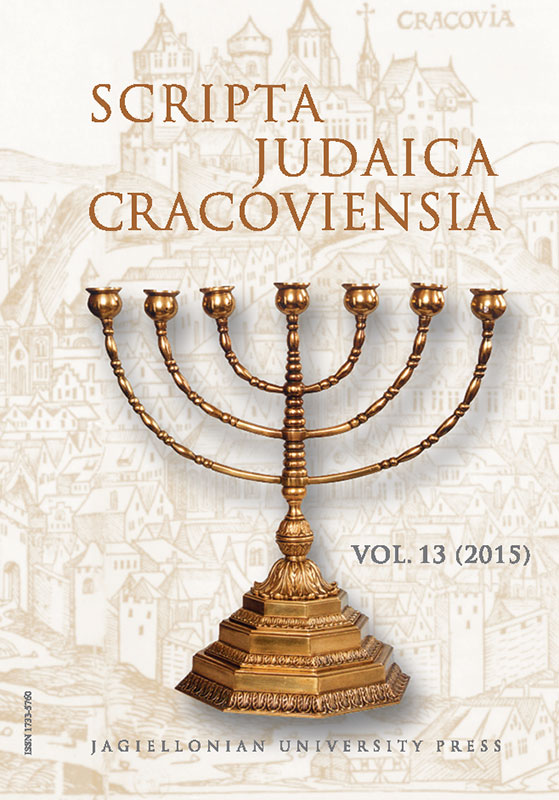
At the time of the Hasmoneans and Herod the Great, the Jews were divided into various “groups” that defined themselves not only by doctrinal positions but also by political choices. These “groups” chose to support or not support the political power. Sometimes they radically changed their position, supporters suddenly becoming opponents, and vice versa. The problem is that the reasons we find in our sources, like Josephus, are often only pretexts.
More...
On two occasions in his description of the siege of Jerusalem in 70 CE, Josephus mentions the “Camp of the Assyrians” as the area in which Titus’ quarters were located. The historian’s account suggests that the location of this site meant that it played an important role in the battles at the city walls. Scholars do not agree on where it was situated, despite the significance of this fact for accurate reconstruction of the progression of the siege of Jerusalem as well as determining the course of the so-called Third Wall. Analysis of the literary and archaeological evidence leads to the conclusion that the name “Camp of the Assyrians” refers to an area lying north-west of the present-day walls of Jerusalem, whose southern borders are demarcated by the remains of an ancient wall unearthed during archaeological excavations and identified by archaeologists as the Third Wall
More...
This article presents the history and religious views of the Kraków’s Association of Progressive Jews in the last quarter of the 19th century, a favorable period in the history of this group. The article discusses certain aspects of the history of this milieu (legal status, authorities, finances, growth), social work it undertook, and the religious life of the Tempel synagogue. Special emphasis was put on the sources of religious standpoint of progressives, on the scope of the religious life, and the preachers’ activities (Moritz Duschak and Samuel Landau at that time). The article contributes to the research on Progressive Judaism in Polish lands and to the religious history of Galician and Krakovian Jewry.
More...
The article is devoted to the pro-Polish integrationist group, an important part of the modernizing section of the Jewish community in Poland, in the second half of the 19th century. The author focuses on Ojczyzna, a Polish-language bulletin and the first regular Polish-language newspaper of the pro-Polish integrationist group in Galicia. The study is an attempt to show how the idea of integration was finally abandoned at the turn of the century, and integration ceased to be seen as the solution to “the Jewish question.”
More...
The article summarizes and highlights some sections of the autobiography of Abraham Stub, a Jew born in Bobowa into a family of adherents of the Bobower Rebbe. In his early childhood Stub migrated with his parents to Mainz in Germany, later escaping the Shoah to Palestine, where he managed to establish a store in the center of West Jerusalem (Ma‛ayan Stub). The autobiography, written in Hebrew, was until recently unknown, although it contains interesting information about the relationship of Jews from Bobowa with their home town after migration, as well as transmitting remarkable biographical details about Rebbe Ben Zion Halberstam’s life in Bobowa. Stub depicts himself as a traditional Jew who during and after World War I and his service in the Austrian army became more and more a religious Zionist. His book thus also provides many insights into the early development of the Mizrahi movement in Germany, where Jews from Eastern Europe, especially from Galicia, were often discriminated against by German Jews and therefore established their own small prayer circles (Mahzike ha-das). Stub’s life story developed from this traditional Hasidic Diaspora background into a typical religious Zionist, so to speak Israeli orthodox biography. It might serve as an example for further studies about migration from the East to the West and further on to Israel, where Jews from Poland or a Polish background still play a dominant role in the political and religious public sphere.
More...
For more than six years, Rola – a Warsaw periodical that appeared weekly from 1883 to 1912 with a circulation of two thousand copies – published a series of articles about the position of wealthy Jewish families in Polish society. This series was commissioned by editor-in-chief Jan Jeleński and was of a quasi-documentary character (fictional but based on facts from real Jewish families with changed names). The title of the series was “Podskarbiowie Narodu” [The Treasurers of the Nation].The vocabulary used in this series expressed the phobias and anxieties of Rola’s staff, among which the biggest was the fear that Jewish families would take over Polish society and infect it with cynical philosophy, ruled by money. This would confirm the negative stereotype of the Jew always preoccupied with money and chasing after a “golden calf.”Jeleński and his colleagues believed that the Jewish nature was different than the Polish one, being based on lower-level values and therefore very dangerous. Once infected, Polish families could later imitate that cynical approach. They were also afraid of the way Jewish families supported each other strongly. Jeleński perceived this support – though of great value for the Jews themselves – as a great threat. He worried that Jewish families grew stronger and united, building a new kind of clan of a nouveau-riche character based on fictitious splendor and dominant influence.
More...
The article deals with the subject of popular demonology as a space of symbolic contact between Jewish culture and the largely Slavic surrounding culture(s) in the Eastern Europe. It brings together two main themes – the presence of Christian beliefs about witchcraft, and demonic representations of diseases (e.g. kolten, hartsvorem, etc.) – as seen and evaluated within the Ashkenazi milieu at the turn of the 20th century. Based on print and handwritten sources of various origins, the article presents examples of extensive intercultural contact, emphasizing their scope and meaning, as well as their limitations, in historical/cultural context.
More...
This article discusses the Bund’s gender politics present in Tsukunft, the youth organization of the party. In the interwar period Tsukunft grew into one of the most active and dynamic organizations within the Bundist movement in Poland. The author analyzes Tsukunft’s discourse to find out the actual position of the women in the organization. By confronting the organization’s material with the sources produced by the movement’s women activists, the author tries to find out more about women’s experience in Tsukunft. The article therefore incorporates the marginalized narrative of and on Jewish women into modern historiography
More...
The painter Sasza Blonder (1909-1949) was born into a tradition-observing Jewish family in Chortkiv in Podolia. In the 1930s he belonged to the avant-garde Grupa Krakowska, whose members were Poles and Jews of radical left views. His works of that period included both abstract and figurative compositions. He was the only artist in the group interested in subjects taken from Jewish life, examples of which can be found in his sketchbooks. In 1937 Blonder moved to Paris. During the war he hid in the south of France under the false name André Blondel. His memoirs written at this time testify to Blonder’s strong links with the Jewish milieu. His death at the early age of 40 interrupted the career of this interesting and talented artist.
More...
The article examines Yiddish-Polish writers’ response to the Holocaust in their poetry written in the years 1941-1948 and published in Poland in the early postwar years, when the country enjoyed relative political freedom. Special attention is given to a highly interesting theme appearing in the wartime lyrics written by Jewish survivors in the East (like B. Heller, H. Rubin, R. Żhikhlinsky, A. Zak), i.e. their call to arms addressed to the Jews living in Nazi-occupied Poland. The refugees could not bear the thought that whole masses of Jews died without putting up a fight in the ghettoes and camps in the West. It was probably this helplessness that evolved into their poetic appeal addressed to their ghettoized brethren, their call for resistance and punishment of the Nazi German murderers. Interestingly, the works of some writers who survived in the ghettos (such as Y. Shpigl, Y. Katsenelson and others), prove that ghettoized Jews who were tormented by the “docile death” complex also dreamed about being involved in an armed struggle against the Nazi Germans, but were aware of their weakness in the face of a much stronger enemy. Immediately after the war, this discrepancy of experience and knowledge led to a serious lack of understanding between those Jews who had survived in Poland and those who had survived in the East. The article examines these difference of experiences as it is reflected in the poetry.
More...


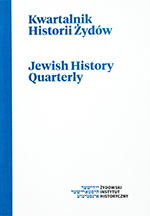
The origins of Karaism, the reasons for its inception, and the nature of this religious movement at the initial stage of its development are matters of ongoing academic dispute. Even the meaning of the name “Karaites” as well as the dating of their emergence on the stage of history are debatable. The paper surveys three major scholarly hypotheses concerning its provenance: 1. Judeo-centric, which indicates the similarities between the Judean Scrolls and medieval Karaite texts (especially in terms of exegetical methods and terminology), and on this basis claims the existence of a direct—historical or conceptual—connection between the Qumran sectarians and the Karaites; 2. Islamo-centric, which focuses on the parallels between Karaite and Muslim religious legislation and customs, as well as theological discourse, and emphasizes the Islamic context of split that occurred within the medieval Jewish world into Rabbanites and Karaites; 3. Finally, the so called “theory of fusion,” which offers a complex view of Karaism as an outcome of merging of various heterodox—both Jewish and Muslim—elements. The article assesses all these diverging views and attempts to find common grounds among them. It also shortly reviews the ideology advocated by the early adherents of Karaism—the rejection of the Oral Law, the diaspora, and the Aramaic language (as means of religious literary expression), and the consequent call for return to the Written Law, the Land of Israel, and the Hebrew language—and juxtaposes these theoretical “ideals” to historical reality, in which the Karaites produced their own Oral Tradition, most of them lived in diaspora, and many of them (at least throughout the Middle ages) composed religious texts in languages other than the “holy tongue.” The concluding conjecture is that probably thanks to its ability to compromise and adapt to the changing historical conditions, Karaism could survive as a separate religious grouping within the Jewish world for over a thousand years.
More...
This year we are planning to publish the Sefer ha-bahir treatise in a bilingual, Hebrew-Polish version. The text is to be preceded by a foreword explaining the circumstances in which the treatise was born and presenting an ideological panorama of Judaism of those times, supplemented by essays concerning the theology, vocabulary and subsequent impact of the treatise on the religious life of the Jews of the Polish diaspora. This plan involves a number of problems that have to be resolved by the publishers already at the outset. These include first of all the choice of one of the number of versions of the text at the basis of translation and the difficult problem of translating the title of Sefer ha-bahir. The purpose of this article is to present these problems precisely.Sefer ha-bahir is a Hebrew theological text, widely regarded as the first, “foundation” deed, of the Mediaeval Jewish cabal. A closer analysis of Sefer ha-bahir suggests that it was recorded by a group of mystics who until then closely followed the classical principles of oral tradition. About a hundred hand-written copies of the treatise have been preserved, the oldest of them being a manuscript kept in the Bavarian Library in Munich, presumably from the late 13th century. The first printed edition of Bahir appeared in Amsterdam in 1651. That editio princeps was based on a text that differs quite significantly from the Munich version. According to information appearing on the title page, the printing of the work was the initiative of Jews arriving from the Republic of Poland. It subsequently served as the basis of a number of editions all the way until the early 20th century coming from printing shops connected with the Polish diaspora only (Berlin, Jabłoński’s printing house 1706; Szkłów 1784; Lviv 1800; 1830; 1865; Vilnius 1883; 1913). This state of affairs makes it easier for us to decide which version should serve as the basis for the Polish edition of Sefer ha-bahir. Our objective, after all, is not just to enable the reader to get to know this important text and sum up its theology but also to present the version that had the biggest impact on the spiritual life of Polish Jews. A comparison of the Amsterdam edition and the Munich version suggests that the source on which editio princeps was based appears to be older and closer to the text recorded by the Languedoc mystics from the 1st half of the 13th century. The meaning of the word bahir appearing in the title poses a separate problem. Borrowed from the Book of Job (Job 37.21), it is a typical hapax legomenon in the Hebrew Bible. Its meaning is not clear. On two occasions, the phrase ’or bahir (bahir light) appears in the treatise. Nearly all the readers and interpreters of the treatise understand bahir as the adjective “bright” or “shiny”. However, the first interpreter of Sefer ha-bahir, Meir ben Salomon abi Sahula in the text entitled ’Or ha-ganuz (Hidden light, 1335) understands bahir as “covered” or “cloudy”. Modern linguistic studies confirm Sahula’s intuition. A closer analysis of the literary and theological context of the word bahir in the treatise suggests that one should follow these traces and, defying tradition, render the title as “The Book of hidden light”.
More...
The Jesuit Jan Bohomolec, a mathematician and philosopher, parish priest in Skaryszew and Praga, studies various religions and philosophical spread the knowledge of them. Among Warsaw’s intellectuals of the latter half of the 18th century he was an example of a man who, while exposing superstitions and prejudice, at the same time awoke interest in other religions and may have been the first person to build bridges between various religions. His works also contain a few—but really interesting—observations about Judaism and its followers. They could be attesting to the fact that his knowledge of the subject was not based on literature alone. He must have known the Jewish community first hand and may have liaised with rabbis as well.
More...
The article examines the history of the Kraków Progressive Israelites Society between 1918 and 1939. From 1861 the Society had its own synagogue (Tempel) and its members accounted for a considerable part of the Jewish intelligentsia. Prior research into the progressive milieu in the pre-WWII period, Earlier research into the progressive milieu in the inter-war period focused first and foremost on the actions of Ozjasz Thon (1870-1936), who was a preacher and a rabbi of a progressive synagogue. The aim of the article is to describe the activity of the organization which employed Thon and in which he operated while in Kraków.The article looks at the way the society was organized and the structure of its authorities (it was managed based on a charter from 1912, the board was made up of 15 persons), its finance (the main source of revenue were the fees for seats and the main expenses were the salaries of clerical personnel), and its typical members (of whom there were between 450 and 480 in the period in question).Throughout the inter-war period the liturgy at Tempel remained relatively conservative. There was a lot of emphasis on elegance and decorum and the main new element was a mixed female and male choir, which sang during all services. In addition to the regular Sabbath and holy day services, Tempel also hosted Polish patriotic events and Zionist galas. In addition to Thon, two more preachers worked in Tempel: Samuel Schmelkes, and later Hirsz Pfeffer. The progressive association also employed cantors (that post was held in succession by San Dywiński, Ignacy Dembitzer, Dawid Taffel, Lazar Schӓchter), a choir master (Izrael Fajwiszys, Izaak Lust), and male and female singers. The activities of all such persons are described in the article. The source materials used in the article include, next to archived sources and newspapers, also interviews with persons who remember the pre-war Tempel.
More...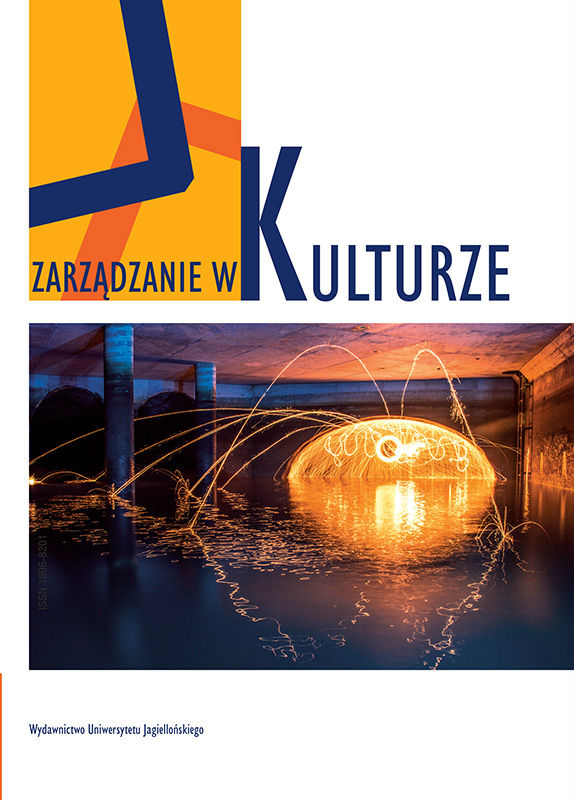
In pre-1939 Poland, there existed the biggest Jewish diaspora in the world (numbered 3.5 million people). It was also the most important centre of Jewish culture. Unfortunately, as a result of the Holocaust, only a small part of the Jewish cultural heritage survived until nowadays. Only about 400 thousand of Jews survived. Despite this fact, in the years 1946–1950 Jewish institutions – the Central Committee of Jews in Poland and The Jewish Society of Promoting of Fine Arts among others – were engaged in gathering and saving objects of Jewish religious art, fine arts and crafts, books, documents and others. They were gathered mostly at the Jewish Historical Institute in Warsaw and also as museum collections. Unfortunately, the origins of these objects haven’t been sufficiently investigated. The accession to the European Union obligated the Polish government to adopt the international agreements connected with the Jewish heritage in Poland: Washington Conference 1998, Resolution of the Council of Europe no. 1205, 1999 as well as Vilnius Declaration 2000 and Terezin Declaration 2009. According to those agreements, in the years 2009–2011 the Ministry of Cultural and National Heritage took efforts to prepare museums to lead provenance research, however unsuccessfully. Nowadays, according to my research, a large number of Polish museums does not carry out any provenance research of objects of unknown origin which may have belong to the Jewish heritage. The main reasons for that are: weak interest in provenance problems and their relation to the Polish and Jewish cultural heritage, too many demands and aims to achieve by museums, luck of funds, fear of restitution, and, last but not least, a weak support of the Ministry of Cultural and National Heritage. Nevertheless, it appears that benefits of the provenance research are more important than the fear of it. First of all, such research contributes to the development of the humanities in Poland, especially art history. Further, it increases trust of Polish and non-Polish citizens in cultural institutions and the government. The fulfillment of the international resolutions mentioned above would improve the image of Poland in the European Union.
More...